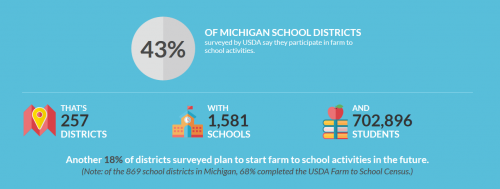The Farm to School Census shows that Michigan programs are having a big impact
The second nationwide Farm to School survey shows that programs are putting nearly $20 million into local economies and benefiting more than 700,000 students.
Farm to School programs have been happening around the country for years. In 2010, through the Healthy, Hunger-Free Kids Act, a national Farm to School program was established within the USDA. The efforts of this program have included tracking activity and growth of Farm to School programs nationwide. In 2013, the USDA conducted the first Farm to School Census. Last year in 2015, the second Farm to School Census was conducted, measuring Farm to School activities throughout the nation for the 2013-2014 school year.
This census provides us with exciting information about Farm to School nationwide and demonstrates sizeable growth in these programs from the first census results.
In total, the census surveyed more than 18,000 school districts, of which approximately 70 percent responded. In Michigan, an impressive 43 percent of Michigan school districts responded that they participate in Farm to School activities. This includes 257 districts, comprising 1,581 schools. The efforts of these districts and schools touched 702,896 students with Farm to School activities. An additional 18 percent of districts that were surveyed said they plan to start Farm to School activities in the future. In Michigan, we have 869 school districts, and 68 percent completed the census.
Michigan survey results | Photo from USDA Farm to School Census
Farm to School includes sourcing local food for school meals and educational activities like growing school gardens to support these efforts. In Michigan, the local sourcing landscape was noteworthy. Of those surveyed, districts reported spending $19,392,100 on local food in the state. The average school district surveyed was spending 20 percent of their total food budget on local products. Michigan school districts are currently buying the following types of local foods: 83 percent fruits, 77 percent vegetables, 56 percent milk and 16 percent meat or poultry. Of the survey respondents, 50 percent plan to increase local food purchases in the future.
Census results also show increased educational opportunities for Michigan students. Of the districts surveyed, 44 percent said they maintain gardens where students learn about how food grows. This represents an increase of 42 percent from previous Farm to School Census reports. A conservative estimate is at least 180 school gardens are being grown and used in Michigan. Across the country, 7,101 school gardens are being used to support Farm to School efforts.
According to some of the schools that were surveyed, benefits of their Farm to School programs include: enjoying lower school meal program costs, greater acceptance of new meal pattern, increased participation in school meals, and greater community support for school meals.
In Michigan, the Michigan Farm to Institution Network (MFIN) supports local food sourcing for all institutions, including schools. MFIN is aiming for the goal of all institutions sourcing 20 percent of their food locally by the year 2020. Participating in MFIN activities as an institutional representative, producer, distributor, advocate, researcher or other interested party is one way to assist in these efforts of getting more local food in institutional meals, increasing nutritious and educational opportunities for students and clients, and benefitting Michigan’s agricultural economy. Michigan State University Extension is an active member of MFIN, and supports the expansion of Farm to School programs across the state.



 Print
Print Email
Email




